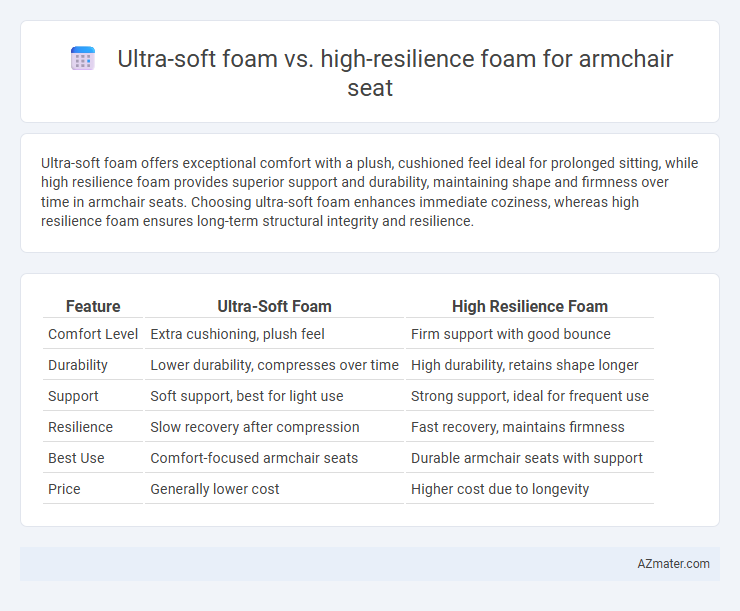Ultra-soft foam offers exceptional comfort with a plush, cushioned feel ideal for prolonged sitting, while high resilience foam provides superior support and durability, maintaining shape and firmness over time in armchair seats. Choosing ultra-soft foam enhances immediate coziness, whereas high resilience foam ensures long-term structural integrity and resilience.
Table of Comparison
| Feature | Ultra-Soft Foam | High Resilience Foam |
|---|---|---|
| Comfort Level | Extra cushioning, plush feel | Firm support with good bounce |
| Durability | Lower durability, compresses over time | High durability, retains shape longer |
| Support | Soft support, best for light use | Strong support, ideal for frequent use |
| Resilience | Slow recovery after compression | Fast recovery, maintains firmness |
| Best Use | Comfort-focused armchair seats | Durable armchair seats with support |
| Price | Generally lower cost | Higher cost due to longevity |
Introduction to Armchair Seat Foam Types
Armchair seats commonly use ultra-soft foam or high resilience foam to balance comfort and durability. Ultra-soft foam offers exceptional cushioning for plush seating, ideal for relaxation environments, while high resilience foam provides superior support and maintains shape longer under frequent use. Selecting the right foam enhances ergonomic comfort and extends the lifespan of armchair upholstery.
What is Ultra-Soft Foam?
Ultra-soft foam is a type of cushioning material characterized by its low density and high compressibility, offering an exceptionally plush and gentle seating experience. It conforms quickly to body contours, providing immediate comfort and a cloud-like feel, but may lack long-term support and durability compared to high resilience foam. Ideal for armchair seats designed for short-term lounging or decorative purposes, ultra-soft foam prioritizes softness over structural integrity.
What is High Resilience Foam?
High Resilience (HR) foam is a high-density polyurethane foam known for its superior durability, elasticity, and support, making it an ideal choice for armchair seats that require long-lasting comfort. Unlike ultra-soft foam, which prioritizes initial softness and cushioning, HR foam maintains its shape and resilience over time, providing better posture support and preventing sagging. The open-cell structure of high resilience foam allows for enhanced breathability, contributing to a cooler seating experience.
Comfort Comparison: Ultra-Soft vs High Resilience Foam
Ultra-soft foam offers exceptional cushioning with a plush, cloud-like feel, making it ideal for users seeking immediate comfort and gentle support in armchair seats. High resilience foam provides a firmer, more durable structure that maintains its shape and offers enhanced support, promoting better posture and longer-lasting comfort. While ultra-soft foam excels in softness, high resilience foam is superior in responsiveness and longevity, catering to different comfort preferences and usage needs.
Durability and Longevity Differences
High resilience foam offers superior durability and maintains its shape longer under frequent use, making it ideal for armchair seats requiring consistent support and longevity. Ultra-soft foam prioritizes comfort with a plush feel but tends to compress faster, potentially leading to quicker wear and reduced structural integrity. Choosing high resilience foam ensures better long-term performance, while ultra-soft foam suits occasional seating where immediate softness is preferred over durability.
Support Levels: Which Foam is Better for Posture?
High resilience foam offers superior support for armchair seats due to its excellent durability, responsiveness, and ability to maintain consistent shape under pressure, promoting better spinal alignment and posture. Ultra-soft foam provides a plush, cushioned feel but lacks sufficient structural support, making it less effective for long-term posture maintenance. Choosing high resilience foam is optimal for users seeking enhanced ergonomic benefits and improved support levels in armchair seating.
Price Comparison: Ultra-Soft Foam vs High Resilience Foam
Ultra-soft foam typically costs less than high resilience foam, making it a budget-friendly option for armchair seats. High resilience foam, known for its durability and superior support, generally commands a higher price due to its advanced material properties. Choosing between the two depends on balancing initial cost against long-term comfort and longevity.
Ideal Users for Each Foam Type
Ultra-soft foam is ideal for users seeking plush comfort and cushioning in armchair seats, such as those with lower body sensitivity or who prefer a sinking, cozy feel during extended seating. High resilience foam suits individuals requiring durable support and bounce-back properties, including active users who frequently sit and stand or prefer firmer seating for posture support. Seniors and office workers benefit from high resilience foam's combination of comfort and durability, while ultra-soft foam appeals to relaxation-focused users in home lounge settings.
Maintenance and Care Requirements
Ultra-soft foam for armchair seats requires frequent fluffing and rotation to prevent permanent indentations and maintain comfort, while its delicate structure may retain stains more easily. High resilience foam demonstrates superior durability, resisting deformation over time and needing less frequent maintenance, making it ideal for high-traffic use. Cleaning both foams involves spot treatments with mild detergent and avoiding excessive moisture to preserve their structural integrity and prolong seat lifespan.
Which Foam is Best for Your Armchair Seat?
Ultra-soft foam offers exceptional comfort by providing a plush, cushioned feel ideal for relaxation, while high resilience foam delivers superior support and durability, maintaining its shape under frequent use. For armchair seats, high resilience foam is typically best because it combines long-lasting performance with adequate softness, preventing sagging and ensuring ergonomic support. Selecting the right foam depends on usage patterns: ultra-soft foam suits occasional seating, whereas high resilience foam is optimal for daily use and prolonged seating comfort.

Infographic: Ultra-soft foam vs High resilience foam for Armchair seat
 azmater.com
azmater.com